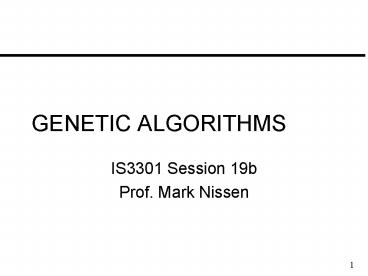GENETIC ALGORITHMS - PowerPoint PPT Presentation
1 / 12
Title:
GENETIC ALGORITHMS
Description:
Expert not always available/willing/able. Knowledge engineering bottleneck ... GHI. JKL. MNO. PQR. STU. VWX. YZA. PQJ. PNR. XYZ. JKM. MNP. PQO. PQR. JKX. MNQ ... – PowerPoint PPT presentation
Number of Views:30
Avg rating:3.0/5.0
Title: GENETIC ALGORITHMS
1
GENETIC ALGORITHMS
- IS3301 Session 19b
- Prof. Mark Nissen
2
Agenda
- Machine Learning
- ACME Transportation Problem
- Genetic Algorithms
- Learning Exercise
- Examples Demos
- Summary
3
Machine Learning
- Increase knowledge in systems
- Generalize across specific instances
- Knowledge enhances problem solving
- Learning enhances knowledge
- Rule-based problems
- Expert not always available/willing/able
- Knowledge engineering bottleneck
- No one knows how to solve problem
- Static knowledgebase, dynamic environ
4
Machine Learning Approaches
- Symbolic
- Induction - rules from examples (ID3/VPX)
- Chunking - generalize rules (Soar)
- Analogy - reason from past cases (CBR)
- Explanation - generalize with theory (EBL)
- Numerical
- Statistics - fit models to data (regression)
- Neural nets - fit network to data (ANN)
- Genetic algorithms - evolve pop to fit data
- Supervised training most common
5
AMCE Transport Problem
- Plan delivery routes
- 25 overseas locations
- 25! Different possible routes
- Evaluate 1M routes/second
- 0.25 of routes since life began on Earth
- NP-complete problem
- Computationally intractable
- Exhaustive search impractical
6
AMCE Transport Problem
- Optimization difficulties?
- Nonlinear functions constraints
- Discontinuities
- Large, sparse search space
- Qualitative factors
- Dont know how to solve problem
- Simulation difficulties?
- Expert system difficulties?
- Gulf War Syndrome example
7
Genetic Algorithms
- Biological metaphor (Darwinian)
- Survival of the fittest (problem solver)
- Evolve population of problem solvers
- Computational chromosomes
- 3 operators
- Selection - only fittest survive
- Crossbreeding - exchange genes
- Mutation - random variation
- Base on fitness in problem space
- Population learns as it evolves
8
Learning Process
Random Population Evolved
Population 1
YZA
MNO
ABC
DEF
PQR
. . . . . . .
STU
GHI
JKL
VWX
Environmental evaluation
9
Mechanics
- ID chromosomes (feature vectors)
- Capture key problem characteristics
- Symbols or numbers (often binary)
- Randomly populate with diverse genes
- Establish fitness function
- Evaluate performance in environment
- Apply operators to population
- Evolve population through generations
10
Learning Exercise
- English vowels (A,E,I,O,U)
- Binary grid representation (0,1)
- Start with 5 random vectors (9-bit)
- Evaluation correct bits
- Select 2 vectors with highest score
- Crossbreed 1 (4 bits from a, 5 from b)
- Mutate best vector (keep 6 bits, change 3)
- Insert 1 totally-random vector
- Evaluate evolve until letter is learned
11
Examples Demos
- Computational examples
- i85l19b1.xls
- i85l19b2.xls
- Curve-fitting demo (check)
- Other examples
- Other demos
- Naval Research Lab
- John Koza (Stanford) video
- Others for you to discover
12
Summary
- Learning - d/dx (knowledge)
- GAs are powerful
- NP-complete problems
- Difficulties with optimization, others
- Dont have to know how to solve problem!
- GAs use biological metaphor
- Darwinian level
- Selection, crossover mutation ops
- Evolve population of problem solvers































